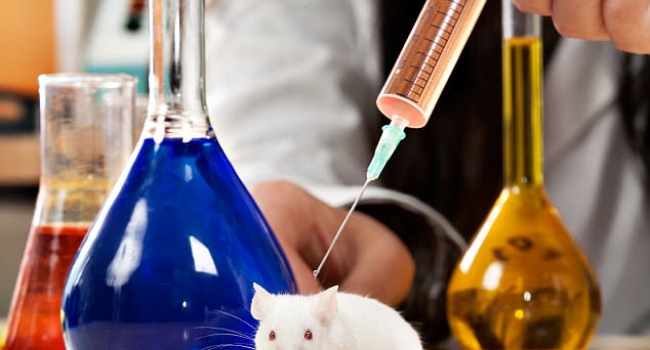- Latest news▼
-
17:25, April 22 Scientists found baked goods and lack of sleep to be more dangerous than alcohol

-
16:02, April 22 342 cases of measles recorded in Armenia so far in 2024

-
15:29, April 22 BrainStimulation: electrical brain stimulation alleviates anxiety and depression in the elderly

-
08:27, April 22 Cognitively stimulating jobs in midlife could lower dementia risk in old age, study finds

-
20:37, April 21 Environmental Health Perspectives: Microplastics ingested with food and water can spread from the gut to the brain

-
22:41, April 20 Scientists develop new method to safely stimulate immune cells to fight cancer

-
20:46, April 20 Blood test can determine who is at risk of developing multiple sclerosis - scientists

-
18:36, April 20 Next pandemic likely to be triggered by flu - scientists

-
12:16, April 19 Scientists grow human mini-lungs in lab

-
10:23, April 19 JAMA Oncology: Urine test can help rule out high-grade prostate cancer with almost 100% accuracy, study shows

-
18:00, April 18 Daily Mail: Elderly woman in China gets infected with brain-eating amoeba

-
14:19, April 18 Obesity: exercising before breakfast helps you lose weight faster

-
10:42, April 18 The Conversation: childhood trauma can cause pathological hoarding

-
08:37, April 18 Daily Mail: Satiating food reduces cravings for sweets, nutritionist says

-
18:22, April 17 First Armenian-German Conference entitled “Heart Failure Spring School”

All materials
Paraplegic rats walk after receiving stem cell therapy in a breakthrough

Paraplegic rats have walked after receiving stem cell therapy, new research reveals.
As The Daily Mail reports, after just three weeks, 42 per cent of the rodents improved their ability to walk and support their weight, a study found.
Some 75 per cent of the animals were able to respond to stimuli on their back legs after being treated, the research adds.
Stem cells differentiate into specialised cells according to where they are in the body, however, for unclear reasons, the therapy was not successful in all of the study's rats.
Nonetheless, study author Dr Shulamit Levenberg from the Technion-Israel Institute of Technology, said: 'Although there is still some way to go before it can be applied in humans, this research gives hope.'
How the research was carried out
The researchers inserted stem cells from humans' mouths into rats with a tear in the spinal cord.
The stem cells, which differentiate into specialised cells according to their environment, then secreted substances for the growth and survival of the backbones' nervous system.
The cells were implanted at various sites along the rats' spinal cords.
Proteins were also added to stabilise and support the rodents' backbones.
Up to 75% improvement
Results reveal, three weeks after receiving the stem-cell treatment, 42 per cent of the rats improved their ability to walk and support their weight on their hind legs.
Some 75 per cent of the rodents responded to stimuli to their back limbs and tail.
Damaged areas of their spinal cord showed some improvement, which suggests backbone healing.
Yet, for unclear reasons, not all of the rats were successfully treated, with additional research being required to uncover why only some rodents benefited.
The researchers wrote: 'This warrants further investigation to shed light on the mechanisms underlying the observed recovery, to enable improved efficacy and to define the intervention optimal for treatment of spinal cord injury.'
Dr Levenberg said: 'Although there is still some way to go before it can be applied in humans, this research gives hope.'
The findings were published in the journal Frontiers in Neuroscience.
Follow NEWS.am Medicine on Facebook and Twitter
- Video
- Event calendar
- Archive
- Most read
month
week
day
- JAMA Oncology: Urine test can help rule out high-grade prostate cancer with almost 100% accuracy, study shows 1134
- Daily Mail: Elderly woman in China gets infected with brain-eating amoeba 1122
- Obesity: exercising before breakfast helps you lose weight faster 1111
- The Conversation: childhood trauma can cause pathological hoarding 1110
- Daily Mail: Satiating food reduces cravings for sweets, nutritionist says 1087
- First Armenian-German Conference entitled “Heart Failure Spring School” 1047
- Why do kids usually recover from COVID-19 more easily than adults? 990
- Scientists grow human mini-lungs in lab 941
- Next pandemic likely to be triggered by flu - scientists 481
- Scientists found baked goods and lack of sleep to be more dangerous than alcohol 423
- Blood test can determine who is at risk of developing multiple sclerosis - scientists 394
- Scientists develop new method to safely stimulate immune cells to fight cancer 381
- 342 cases of measles recorded in Armenia so far in 2024 367
- Cognitively stimulating jobs in midlife could lower dementia risk in old age, study finds 363
- BrainStimulation: electrical brain stimulation alleviates anxiety and depression in the elderly 298
- Find us on Facebook
- Poll





